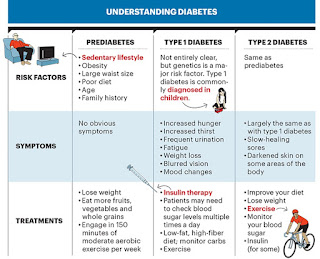One-third of adults have prediabetes, but most don’t know it.
What is prediabetes?
Let’s start with what prediabetes is not. It’s not a disease, and it has no obvious symptoms. So why should you care? Because prediabetes indicates high blood sugar, just not high enough to be type 2 diabetes — yet. It’s an indication that you’re on the path to diabetes unless you alter your eating and fitness habits. The important message: You can probably fix the problem if you take the right steps.
Who is at risk?
The biggest risk factors are obesity and a sedentary lifestyle, says Gregg Simonson, director of professional training and consulting at the International Diabetes Centre in St. Louis Park, Minn. Genetics is important as well: Even lean folks who have a strong family history of diabetes can get prediabetes. The American Diabetes Association offers a test that assesses your risk.Why does prediabetes risk increase around age 45?
The cells of your body require insulin to absorb glucose, which they need in order to function. If you’re younger and you suffer from insulin resistance (a condition in which your cells have a harder time absorbing glucose), your more vigorous pancreas can usually compensate for the problem by manufacturing more insulin. But your pancreas becomes less effective with age, explains dietitian Hillary Wright, director for nutrition counselling for the Domar Centre for Mind/Body Health in Waltham, Mass. That could cause more glucose to accumulate in the bloodstream.What are the obvious symptoms of prediabetes?
There aren’t any. And even though roughly 1 in 3 American adults have prediabetes, 90 percent of those people don’t know it, according to the Centres for Disease Control and Prevention (CDC). That’s why you should get screened starting at age 45. If you have major risk factors, such as obesity and family history, you should get tested even sooner.“Screen early and screen annually,” Simonson says. “If there are no other risk factors, you can probably do it every three years.”
Does prediabetes always lead to type 2 diabetes?
About 15 percent to 30 percent of people with prediabetes will develop type 2 diabetes within five years if they don’t lose weight or engage in moderate physical activity, the CDC reports. And those percentages increase as people age: A 45-year-old with prediabetes has a 74 percent lifetime risk of progressing to type 2 diabetes, says a study published in the Lancet Diabetes & Endocrinology.But prediabetes often can be reversed. Losing as little as 7 percent of your weight can prevent it from progressing to type 2 diabetes, according to the Diabetes Prevention Program, a landmark prediabetes study of more than 3,000 adults published in the New England Journal of Medicine in 2002.
“Weight gain causes harmful changes that strain your ability to properly use insulin,” says Samar Hafida, M.D., an endocrinologist with the Joslin Diabetes Centre in Boston. Hafida adds that overweight people are up to five times more likely to develop diabetes than someone at a normal weight.
Does it matter when you eat?
Healthy, modest-sized meals and snacks spread through the day help keep blood sugar stable. Going hungry most of the day may mean you’ll eat more at night, and that’s harmful. “If you eat most of your food at night, it may be harder for your body to manage those carbohydrates without extra insulin,” Wright says. Research suggests that people are more insulin resistant at night, she adds.How can exercise help?
Exercise makes your cells hungry for fuel and facilitates the movement of sugar out of your blood and into the cells. “Anyone with diabetes who goes for a walk will tell you that their blood sugar went down,” Wright says. “That’s just the physiological effect of exercise.” Simonson recommends strength training and 150 minutes of moderate aerobic activity per week, such as a brisk walk. In a study at the Duke University Medical Centre in Durham, N.C., energetic walking improved oral glucose tolerance better than vigorous jogging in people with prediabetes. The reason: High-intensity exercise primarily burns glucose, while moderate but prolonged exercise burns fat, which is better for long-term blood sugar control.Can you just take a pill?
Sorry — there’s no magic med. In the Diabetes Prevention Program study, people who used metformin, a common prediabetes drug, reduced their risk of developing diabetes by 31 percent. But those who exercised and lost 7 percent of their body weight cut their risk by 58 percent. Metformin is also more effective for those ages 25 to 44 than in older adults. “Healthier eating and physical activity — that is the magic bullet,” Simonson says. “It should be the cornerstone of all diabetes prevention.”http://www.aarp.org/health/conditions-treatments/info-2017/stop-diabetes-before-it-starts.html

No comments:
Post a Comment